| Physics 321 |
Astrophysics II: Lecture #18
|
Prof. Dale E. Gary
NJIT
|
The Milky Way Galaxy - I
Counting Stars
It is a significant
problem to determine the shape and extent of our galaxy from our point
of view inside it. On a clear night with a dark sky, the band of
stars and dust that make up the Milky Way
can be easily seen, but when mapped over the whole sky in optical
light, it has a complicated appearance that does not represent its
real shape.

The first attempts to determine
the shape of our galaxy, called the Milky Way
Galaxy were through simply counting stars. Sir William
Herschel made the first systematic star count in the 1780's, later expanded
by Jacobus Kapteyn the early 1920's. Both of these attempts ignored
interstellar extinction (the dimming of starlight by dust), and concluded
that the Sun resides near the center of a flat, pancake-shaped distribution
of stars.
However, between 1915 and
1919, Harlow Shapley estimated the distances to globular
clusters, using RR Lyrae and Pop II Cepheid variables as distance indicators.
He found that many more clusters where seen in the direction of Sagittarius,
and concluded that globular clusters are distributed uniformly around our
galaxy. The concentration in the direction of Sagittarius was due
to the fact that our Sun is off-center within the galaxy, and the center
is in the direction of Sagittarius.
We can now obtain images
in the infra-red region of the spectrum, which can penetrate dust easily.
When we image the entire sky in the infra-red, as was done with the COBE
satellite, we obtain the much clearer picture of the Milky Way Galaxy shown
below.
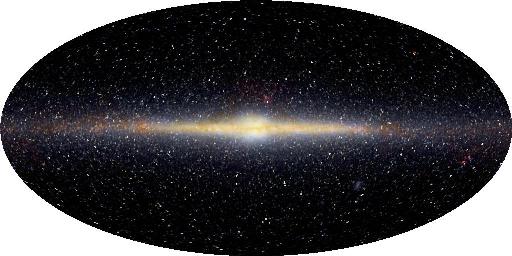
Image of the Milky Way Galaxy
taken with the COBE
satellite.
Note that now we can see through
the dust to the central bulge, and
the disk appears much more uniform. Below are several views of the
Milky
Way seen in various wavelengths.
Morphology of the Galaxy
Below is a figure
that gives an overview of the structure of our galaxy. We will be
discussing different aspects of this figure in the next several lectures,
but for now let's consider only the three main regions.
-
Most of the stars of the galaxy
reside in a disk, which closely resembles
the disks of spiral galaxies seen elsewhere in the sky. Also in the
disk are gas clouds, dust,
and very young stars (O-B associations).
The stars tend to have high metallicity (Z > 0.01).
-
There is a central
bulge of stars near the center of the galaxy that is more spherical
in shape. The stars here are older (and redder) than the disk population.
-
Globular
clusters are distributed in an approximately spherical halo
above, below, and within the disk. A small number of high-velocity
stars are also seen in this halo region. The stars here are
very old, and typically have low metallicity (Z < 0.001)
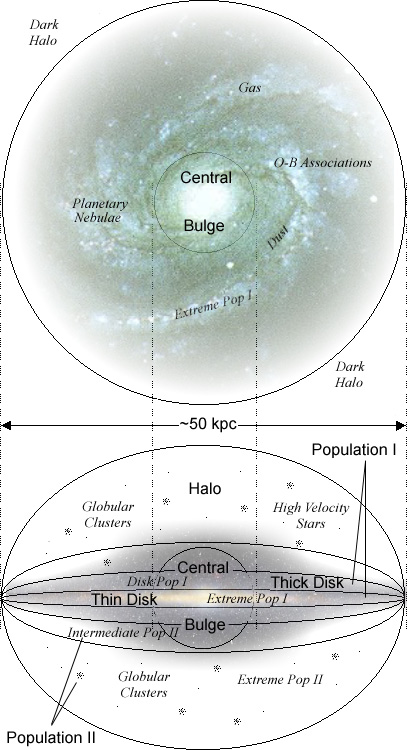
Schematic view of the
Milky Way Galaxy. The top figure shows a "top view" showing the spiral
structure as seen from above. The bottom figure shows an "edge-on
view" as seen from the side. (The top view image is of the spiral galaxy
M100. The side view shows the COBE image from the previous figure.)
In addition to these visible
features, there is indirect evidence of another source of matter, called
dark
matter, which lies in a large halo extending far outside the
visible confines of the galaxy. This makes up the dark
halo. The evidence for this enigmatic matter comes from
studies of the kinematics, or motions, of the constituents of the galaxy.
Kinematics of the Milky Way
As always in astronomy,
the building blocks of great discoveries such as galactic rotation and
the presence of dark matter come from very basic, simple measurements such
as the motions of stars. As we have seen, a star's speed is measured
in two components:
-
radial velocity (from doppler
shifts of spectral lines) and
-
tangential velocity (from proper
motion).
Star catalogs such as the Nearby
Stars catalog give these measurements for each star.
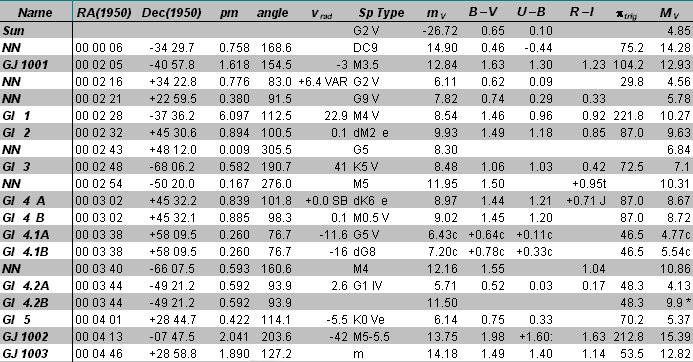
Here, the proper motion (pm,
or m") is
given in arcseconds per year. In these units, the tangential velocity
of the star, in km/s, is
vq =
4.74
m"dpc
=
4.74
m"/p"
(km/s)
where p"
is the trigonometric parallax, in arcsec.
Example: For star
Gl 4.2A, above, we have m"= 0.592
and p"= 0.0483,
so vq
=
58.1 km/s. The radial velocity is shown
in the table to be vr = 2.6
km/s, so the total velocity, or space
velocity is v= (vr2+
vq2)1/2
= 58.2 km/s.
The quantities in the table,
however, are not so simple to measure. To convert proper motion to
velocity, one must know the distance, which means either measuring a trigonometric
parallax (which is impossible for all but the nearest stars) or using a
spectroscopic parallax. In addition, the proper motion must be measured.
For nearby stars, the proper motion can be quite large, but for distant
stars it can be very small. Luckily, we can monitor stars over many
decades, after which the proper motion accumulates and can be measured.
Radial velocity is easier,
since it is determined from spectral line shifts, which can be seen at
any distance (as long as the star is bright enough). However, for
both radial velocity and proper motion one must subtract other motions
such as the Earth around the Sun (~30 km/s), and the Sun's own motion through
space (~19.5 km/s--our text gives 16.5 km/s).
Galactic Coordinates
We learned in the
second lecture that stars are assigned right ascension (a)
and declination (d)
coordinates depending on their positions on the celestial sphere--the
extension of the Earth's equator and poles into the sky. However,
it is often more convenient when discussing the kinematics of the galaxy
to change to a new coordinate system based on the shape and orientation
of the galaxy (the Milky Way) in the sky.
Before we can go further
with stellar motions, we need to define a coordinate system in which to
make our measurements. Since we expect the galaxy to rotate about
its center, and all of the objects that make up the galaxy should orbit
this center in Keplerian orbits, we could form a coordinate system that
is galactocentric, and for some cases
that is the appropriate system to use. However, since we are observing
from our location in the galaxy, a second coordinate system centered on
the Sun will prove more useful. This coordinate system is called
simply galactic coordinates.
As viewed from the Sun, coordinates in the galactic plane are at galactic
latitude b = 0o, while at the galactic
poles (N or S), the galactic latitude is b = 90o.
Galactic longitude l is measured from the center of the galaxy (the
Sagittarius region) as shown in the figure below.
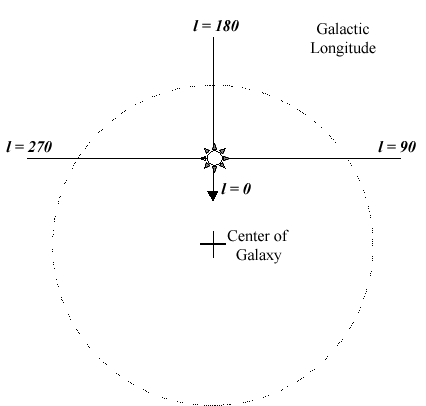

The transformations between
celestial (a,
d)
and galactic (l, b)
coordinates are:
cos b cos (l -
33o) = cos d
cos (a - 282.25o)
cos b sin (l -
33o) = cos d
sin (a - 282.25o)
cos 62.6o + sin d
sin 62.6o (from
celestial to galactic)
sin b = sin d cos 62.6o-
cos d sin (a- 282.25o)
sin 62.6o
sin d = cos b sin (l -
33o) sin 62.6o+
sin b cos 62.6o
cos d sin (a
- 282.25o) = cos b sin (l-
33o) cos 62.6o-
sin b sin 62.6o (from
galactic to celestial)
A graphical representation of
these two coordinate systems is shown below:
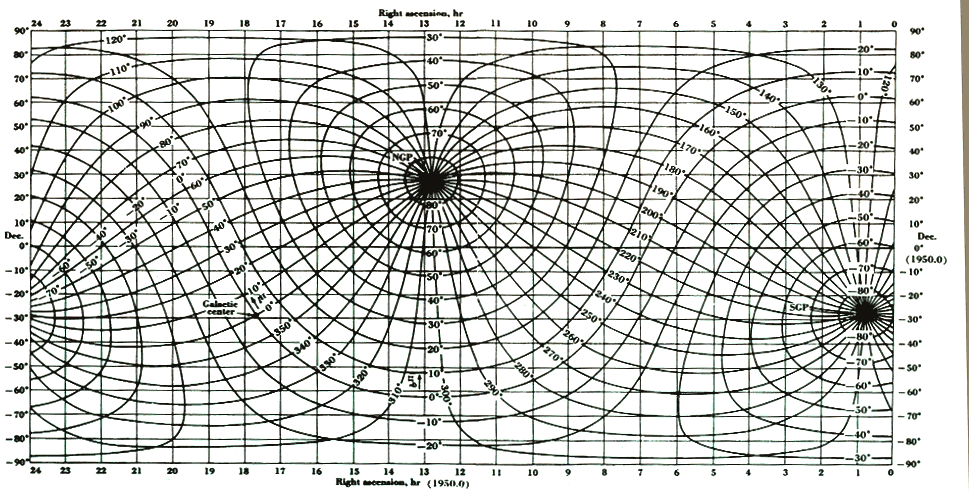 Chart for conversion
of celestial coordinates to galactic coordinates. From Kraus, Radio
Astronomy, Second Edition, Cygnus-Quasar Books, 1986.
Chart for conversion
of celestial coordinates to galactic coordinates. From Kraus, Radio
Astronomy, Second Edition, Cygnus-Quasar Books, 1986.
We define the kinematics
of the system in terms of the rotational motion, about the galactic center,
of all of the stars in the solar neighborhood. This allows the Sun
to have a motion with respect to this average rotational motion.
Assumptions that go into the model are:
-
Stars share the general rotation
of the galaxy.
-
Stars have their own peculiar
motions superimposed on this general rotation.
-
The average velocity (magnitude
and direction) of stars in the local solar neighborhood should be zero
with respect to this general rotation.
-
The Sun may have a motion relative
to the general rotation.
Thus, if we examine all the
motions of stars in the very local solar neighborhood, and their velocities
do not average to zero, any residual velocity must be due to the Sun's
own motion (due to the fact that the Sun's orbit around the galactic center
is not perfectly circular). In fact, stars should (statistically)
show a diverging pattern in the direction our Sun is traveling, called
the solar apex, and show a converging
pattern in the opposite direction (the solar antapex).
Once the apex and antapex are found, we determine the Sun's peculiar velocity
by averaging the radial velocities in these directions. The solar
apex is in the direction toward l = 53o,
b
= 25o, a point in the constellation Hercules.
Local Standard of Rest
These considerations allow
us to define a Local Standard of Rest (LSR).
Stars moving about the galactic center in perfectly circular orbits would
be expected to have zero velocity in this LSR frame.
The other coordinate system,
centered on the center of the galaxy, has coordinates R, q,
and z, corresponding to radial distance from the center, azimuthal
angle, and distance out of the plane. The corresponding velocity
components are defined as P
= dR/dt, Q
= R dq/dt,
and Z = dz/dt. The rotation rate at the radius of the
Sun gives for the LSR velocity: PLSR
= 0, QLSR
= Qo,
and ZLSR = 0, where Qo
is the rotation rate at the radius of the Sun. Peculiar velocities
are then defined as
u = P
- PLSR
= P
v = Q
- QLSR
=
Q
-Qo
w = Z -ZLSR
= Z
Plotting the peculiar velocities
as u vs v, gives the diagram of Figure 22.23 of the text.
Note the different velocity dispersion of different types of stellar
populations. Young stars show little dispersion, so are rotating
along with the general galactic rotation. Older stars show a great
deal of dispersionn, up to 200-300 km/s difference. Note the velocity-metallicity
relation, in which low-metallicity stars have high peculiar
velocities while high-metallicity stars have low peculiar velocities.
Galactic Rotation Curves
We mentioned before that
the stars should orbit the galaxy in Keplerian orbits. For Keplerian
orbits, we expect Kepler's Third Law to hold:
where P is the orbital
period, M is the mass interior to the orbit, and R is the
radius of the orbit. For a circular orbit, the period is related
to the speed by
so the speed V
is
V = (GM/R)1/2
~ R-1/2.
(1)
This is the way that
velocity should fall off with radius as long as all of the mass is interior
to the orbits being considered. In contrast, imagine a spherical
distribution of mass of uniform density, in which particles (stars!) orbit
inside
the mass distribution. The mass interior to the orbit is then
and the equation above
becomes
V = (GM(R)/R)1/2
= G(4pR2r/3)1/2
~ R.
(2)
Clearly, the way that the mass
is distributed in a galaxy will make a big difference in the velocities
of the stars within it. On the other hand, if we can measure the
velocities of stars as a function of radius (the galactic
rotation curve), we can determine the mass distribution in the
galaxy.
If the speed of orbit of
stars depends on radius, then stars far from the solar neighborhood will
not be rotating with the LSR. If equation (1) is valid, stars interior
to the Sun's orbit will rotate faster, while if (2) is valid they will
rotate slower.




